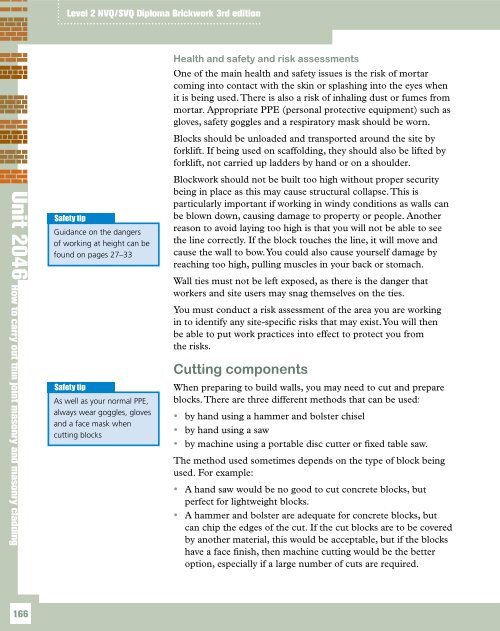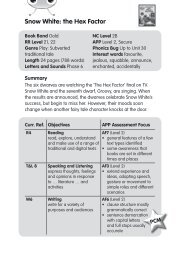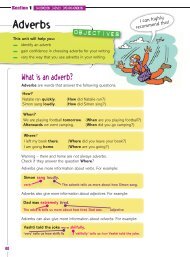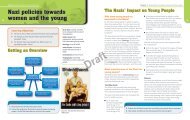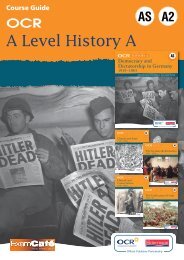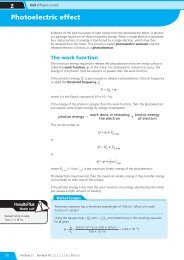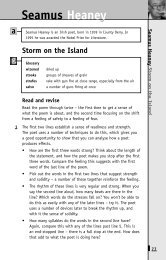Unit 2046 - Brickwork Level 2 CAA Diploma ... - Pearson Schools
Unit 2046 - Brickwork Level 2 CAA Diploma ... - Pearson Schools
Unit 2046 - Brickwork Level 2 CAA Diploma ... - Pearson Schools
You also want an ePaper? Increase the reach of your titles
YUMPU automatically turns print PDFs into web optimized ePapers that Google loves.
<strong>Unit</strong> <strong>2046</strong><br />
How to carry out thin joint masonry and masonry cladding<br />
166<br />
<strong>Level</strong> 2 NVQ/SVQ <strong>Diploma</strong> <strong>Brickwork</strong> 3rd edition<br />
Safety tip<br />
Guidance on the dangers<br />
of working at height can be<br />
found on pages 27–33<br />
Safety tip<br />
As well as your normal PPE,<br />
always wear goggles, gloves<br />
and a face mask when<br />
cutting blocks<br />
Health and safety and risk assessments<br />
One of the main health and safety issues is the risk of mortar<br />
coming into contact with the skin or splashing into the eyes when<br />
it is being used. There is also a risk of inhaling dust or fumes from<br />
mortar. Appropriate PPE (personal protective equipment) such as<br />
gloves, safety goggles and a respiratory mask should be worn.<br />
Blocks should be unloaded and transported around the site by<br />
forklift. If being used on scaffolding, they should also be lifted by<br />
forklift, not carried up ladders by hand or on a shoulder.<br />
Blockwork should not be built too high without proper security<br />
being in place as this may cause structural collapse. This is<br />
particularly important if working in windy conditions as walls can<br />
be blown down, causing damage to property or people. Another<br />
reason to avoid laying too high is that you will not be able to see<br />
the line correctly. If the block touches the line, it will move and<br />
cause the wall to bow. You could also cause yourself damage by<br />
reaching too high, pulling muscles in your back or stomach.<br />
Wall ties must not be left exposed, as there is the danger that<br />
workers and site users may snag themselves on the ties.<br />
You must conduct a risk assessment of the area you are working<br />
in to identify any site-specific risks that may exist. You will then<br />
be able to put work practices into effect to protect you from<br />
the risks.<br />
Cutting components<br />
When preparing to build walls, you may need to cut and prepare<br />
blocks. There are three different methods that can be used:<br />
by hand using a hammer and bolster chisel<br />
by hand using a saw<br />
by machine using a portable disc cutter or fixed table saw.<br />
The method used sometimes depends on the type of block being<br />
used. For example:<br />
A hand saw would be no good to cut concrete blocks, but<br />
perfect for lightweight blocks.<br />
A hammer and bolster are adequate for concrete blocks, but<br />
can chip the edges of the cut. If the cut blocks are to be covered<br />
by another material, this would be acceptable, but if the blocks<br />
have a face finish, then machine cutting would be the better<br />
option, especially if a large number of cuts are required.


